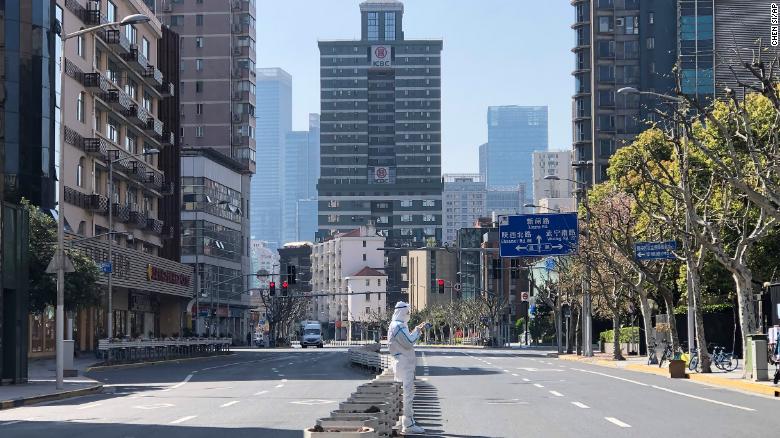Confinement measures tighten in China due to covid-19 0:44
(CNN) --
Millions of people in China's confined financial hub, Shanghai, have desperately sought medical care and basic supplies like food.
Parents have been forcibly separated from young children with covid-19.
And the anger of the population is mounting, with no end in sight as China clamps down.
Since March, China has been fighting the largest wave of covid to date, with Shanghai being the largest source of infection.
All 25 million residents are under lockdown, and Chinese national health and military workers have been dispatched to bolster the city's response.
On Tuesday, the country recorded more than 20,000 new cases, well above Wuhan's peak in 2020, at the start of the pandemic.
Although this figure is still far lower than many other countries, it is a dramatic increase for China, which has adhered to a strict "zero covid" strategy that aims to end all outbreaks and chains of transmission through border controls, mass protests, quarantines and strict confinements.
The sustainability of that policy is now being questioned, as the new, highly infectious variants of covid-19 continue to spread through the population.
advertising
Here's what to know about the latest outbreak.
What parts of China are being affected?
A worker stands on April 4 in the middle of the streets of the city of Shanghai, which is in lockdown due to covid-19.
In early March, COVID-19 cases began to rise in several provinces across the country, including Shandong in the east, Guangdong in the south, and Jilin in the northeast.
By the end of the month, the virus had spread to 29 of China's 31 provinces, according to the National Health Commission (NHC).
90% of the cases identified in March came from Jilin and Shanghai, the two largest sources of infection.
Several cities, home to more than 37 million people, were placed under various levels of lockdown in March.
Many of those closures were eased in early April, leaving Shanghai as the exception, as authorities struggle to get a handle on its cases.
So far, only two Covid deaths have been officially reported during this wave, both in Jilin in March.
What is life like under lockdown?
Shanghai employees sleep in offices after closures 1:11
Shanghai's measures were expanded and prolonged as the situation deteriorated.
In late March, the Shanghai government denied it had plans for a city-wide lockdown, even calling the reports "false" and disrupting the "social order".
On March 27, the government announced that it would implement a staggered lockdown, first in one half of the city and then in the other.
On March 31, the government abandoned its staggered approach and imposed a citywide lockdown on the 25 million residents, who were prohibited from leaving their neighborhoods except to undergo testing.
Mandatory testing across the city has seen an increase in cases, officials say, prompting them to extend the lockdown until further notice as they "do more tests, review results, transfer positive cases and look at the overall COVID situation." ".
To enforce these measures and meet the demands of the entire isolated population, more than 30,000 doctors and 2,000 military workers were sent to the city, according to state media and the People's Liberation Army.
But the restrictions also sparked an unusual rise in public frustration and criticism of the government, with residents describing difficulties accessing basic supplies such as food or medicine.
China recruits the Army as Shanghai orders covid testing of 25 million residents
Anger grew last month following the death of an off-duty nurse in Shanghai, who was turned away from her own hospital's emergency room because it was closed for disinfection.
Another Shanghai resident died after suffering a medical emergency at his home before he could reach the hospital.
“We have not been killed by covid, but by covid control measures,” read a popular comment on the heavily censored Chinese social media platform Weibo.
There was also fresh outrage over Shanghai's policy that all Covid-positive patients in the facility be isolated, including young children and infants.
One mother told CNN that she had been separated from her infected 2-year-old daughter on March 29, and that she was not allowed into the isolation room to stay with her daughter until a week later. .
On Monday, a Shanghai quarantine center launched a quarantine zone for parents and children.
And on Wednesday, Shanghai health authorities announced they would amend the policy, allowing parents who test negative to request permission to accompany covid-positive children with "special needs."
They did not specify what conditions would qualify as "special needs."
Parents who test positive can also accompany their COVID-positive children into the quarantine facility.
Which variant is spreading?
Omicron has driven this increase, with cases identified showing both BA.1—the original omicron—and other descendant lineages, including BA.1.1 and BA.2.
BA.2, first detected in January, is now the leading cause of Covid-19 globally and the dominant strain in the United States, according to the World Health Organization and US health officials.
What we know about the BA.2 subvariant: Now the dominant cause of COVID-19 in the United States
Since its appearance, international case counts — which had fallen since the first week of January — have risen again.
Studies also suggest that BA.2 is much more contagious, although researchers are still studying the severity of this subvariant.
Some epidemiologists say its basic reproduction number can be as high as 12, meaning that each sick person infects an average of 12 others.
This would put it on the same level as measles, which is also spread through the air.
The basic reproduction number of the BA.1 is estimated to be approximately 8.
Will China continue with the zero covid strategy?
This is what Shanghai looks like on the first day of confinement due to covid-19 0:50
As the outbreak drags on, experts and international observers speculate whether this wave, the most transmissible variant, and China's mass vaccination campaign could spell the end of the zero covid strategy.
As of Friday, about 78% of the country's 1.4 billion people had been fully vaccinated, according to the CNS.
Before the outbreak, scientists and leaders had hinted that they were re-examining the strategy, with a prominent epidemiologist writing on Weibo in early March that Covid-zero "would not last forever."
But that now seems like a distant future, as Chinese authorities have made it clear that they consider the alternative — the virus spreading across the country, potentially overwhelming the health system — to be the worst option.
Wu Zunyou, chief epidemiologist at the Chinese Center for Disease Control and Prevention, stated on Friday that China "will continue to focus on a dynamic zero-Covid policy," according to the state-run Global Times tabloid.
The easing of restrictions and opening of borders seen in other countries could "cause many problems, such as reduced medical resources and increased deaths," he added.
And on Monday, Vice Prime Minister Sun Chunlan said in Shanghai that the city needed "a more determined attitude, more forceful actions and more effective coordination" to achieve zero covid.
ChinaCovid-19




/cloudfront-eu-central-1.images.arcpublishing.com/prisa/OOLBKF5K4VFN7EA7IFFA4PMVUE.jpg)



